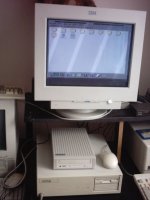Well, first off, it'd look like my GEM 386 that I used to have....so this....
As for the system, it'd be a 486 based PC with a AMD 5x86 133 CPU, and 4 different clock speeds (33MHz, 66MHz, 100MHz, and 133MHz) that can be switched on the fly by multiplexing oscillators of varying speeds. The bus itself would have 4 ISA slots, 2 with VLB Local bus extentions, and 3 PCI slots. That way it could be purchased as a barebones kit one can put their own vintage hardware in that they prefer. Maximum RAM is 256MB with a 1024K (1MB) L2 cache. CMOS battery is a CR2303 coin cell like a modern PC, the BIOS is flashable and able to be backed up, and the board can take mSATA SSD drives including our own cheap, low capacity versions.
The idea would be a DOS Gamer/retro-gamer oriented computer aimed at providing a cost effective retro-gaming solution to the market that's still compatible with your old hardware/software, but forwards compatible enough to allow one to use modern storage mediums for data storage.
As for the dwindling ISA, VLB, and PCI hardware? We would offer a limited selection of very well designed hardware aimed at making the machine compatible with modern peripherals to make life of DOS retro-gamers easier. Such as replacement keyboards and mice that have alps keyswitches - my main models would be the Microspeed PC-Trac Trackball, the Microsoft "Dove Bar" mouse, and the IBM Model "M" and Northgate Omnikey 102 Keyboards.
For screens, we offer a retro-themed 14" LCD in either anti-glare or gloss. These screens are regular VGA at 1024X768 resolution interlaced - basically designed to simulate a CRT without the size and power consumption of one.
the replacement cards would include a PCI SATA card, a PCI Graphics card with HDMI, SVIDEO, and COMPOSITE out, and a PCI Gigabit LAN card, as well as an ISA SB16 compatible Soundcard with Wavetable support. A PCI version that is 100% the same but for PCI bus with Multiplexing would also be available. This would continue the "Razor/Blades" model of sorts. You buy the chassis, and change it as needed.
As technologies and whatnot change or become hard to get, we would provide solutions to continue the DOS legacy.
Pre-Loaded/Preconfigured models would also be available with FreeDOS as the pre-loaded Operating system.
There also would be a SFF and Embedded version so we could expand into the Embedded applications and provide a smaller All-In-One PnP solution for people not as hardcore into retro DOS gaming as to want to take up an entire desk with it.


